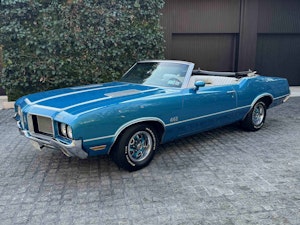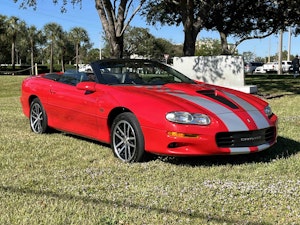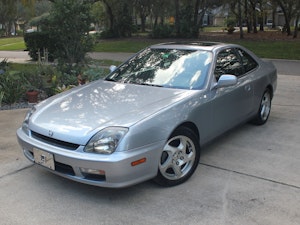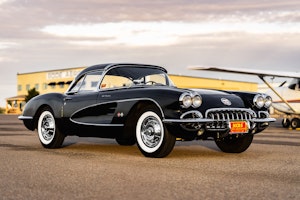Personal Import Report: Volkswagen Golf GTI Mk 1
The EPA and DOT allow individual vehicles over 25 years old to be brought into the country as personal imports, exempt from meeting the standards originally imposed on them. You can take advantage of this allowance to pick up some forbidden fruit from an earlier time and be the star of your next Cars and Coffee show. Here is an example of one such model that qualifies and is sure to get looks from all of the right people.
Subject: Volkswagen Golf GTI Mk 1 (1976-1983)
Current values: From ~ €4000/$5500 (eBay.de)
Best place to buy: Germany, France
Just as the world was getting acquainted with the idea of water-cooled Volkswagens, Wolfsburg dropped a surprise at the 1975 Frankfurt Motor Show with a high-performance version of the still-new Golf. With a fuel-injected engine borrowed from the Audi parts bin, a lower suspension, bigger wheels and tires, and deep chin spoiler, the Golf GTI was the result of a handful of passionate engineers who worked off hours to bring the first “Sport Golf” to fruition.
Marketplace
Buy and sell classics with confidence
The Volkswagen board, unconvinced of the potential for a small, efficient performance car in the midst of a worldwide energy crisis, reluctantly approved the project as a homologation special, giving the go-ahead for the short run of 500 examples needed to qualify for production class road racing. By the time the Geneva show wound down, VW had orders for its initial run, and it became clear that the Golf GTI was exactly the car for the times.
That first GTI used a 1.6-liter 8-valve engine, cribbed from the Audi 80 GTE. The simple, robust design employed Bosch K-Jetronic mechanical fuel injection and a high-compression “heron” head (flat head, dished pistons) to produce a heady 110 hp, with a healthy supply of torque (103 lb-ft) in the mid range. This was mated to a close-ratio 4-speed gearbox, driving the front wheels through bigger axles.
The chassis sat 10mm lower to the road than a standard Golf thanks to shorter, stiffer springs. Boge sport dampers and a front anti-roll bar helped the 1,650-pound car corner flat and put down power. Front brakes were upgraded to discs, also borrowed from the Audi 80 GTE. Fourteen-inch steel wheels were the standard spec initially, though alloys eventually made their way onto the GTI as a more stylish alternative.
Visually, the GTI stood apart from the run-of-the-mill Golf with its deep front “duck bill” chin spoiler, a red stripe surrounding the grille, a tailgate blackout trim, and twin black stripes decorating the lower part of the body, not unlike Porsche’s 911 Carrera motif. One front and one rear badge spelled out the GTI moniker for those who may not have read the more subtle clues.
Owing to its intended purpose, the interior was dark and sparse, with a pair of sport seats trimmed in plaid cloth, a three-spoke sport steering wheel and a pair of additional gauges – oil temp and oil pressure – keeping the driver focused on the business at hand. Borrowing again from the Porsche playbook, the earliest models had no offside rearview mirror and no glovebox door to keep both weight and cost down. To prove they still had a sense of humor, the engineers specified a dimpled “golf” ball shape for the GTI’s shift knob.
For 1982, the 1.6-liter engine (and its heron head) gave way to a slightly bored and significantly stroked 1.8-liter version, though horsepower was still rated at 110. By this time, the Golf GTI was a certified cult hit with driving enthusiasts of all stripes. Its popularity allowed a host of content upgrades, including nicer interior trimmings, air conditioning, and additional driving lights in the grille. Production ended in 1983 to make room for the second-generation Golf and, not surprisingly, its GTI counterpart.
Volkswagen of America was slow to respond to enthusiasts’ demands for a GTI based on the U.S.-spec Rabbit. The first weak attempt was the 1981 Rabbit S, a classic sticker package with a sportier appearance but the same 81-hp engine as other ’82 Rabbits. No one was fooled, and for the following year the U.S. finally got a real GTI. Detuned to 90 hp, the light and nimble 1983 Rabbit GTI nevertheless was a breath of high-performance air at a time when dinosaur Corvettes huffed out as little as 180 hp through their smog equipment. It was an instant hit.
Running through the same close-ratio gearbox as its European equivalent, the GTI was quick off the line and eager to respond. A stiffer suspension, 14-inch alloys and upgraded front brakes backed up the more powerful engine. It had the looks too, with a deep, squared-off front apron, dark bumpers, red stripes in the grille with GTI emblems painted to match.
Because the American GTI was based on the Westmoreland, Pa.-built Rabbit, it shares very little with the European Golf on which it was originally based. Rabbit GTIs had square headlights with wrap-around front turn signals, larger U.S.-only taillights, and large, heavy bumpers with ugly overriders.
True to the times, VWoA applied a thick coat of Americanization to the GTI for us Yanks. Instead of the sporty plaid cloth, our sport seats were covered in striped corduroy velour in suffocating shades of dark navy or deep burgundy that would have looked just as appropriate in a Monte Carlo. A large plastic four-spoke wheel sat where a leather-trimmed three-spoker should have, but at least the golf ball shifter made the trip.
For Volkswagen enthusiasts, owning a Euro-spec first-gen GTI is akin to Porsche aficionados getting hold of an early 911. Thanks to their popularity, a lot of them were produced, but as with so many other entry-level performance cars, they often fell into the hands of owners who couldn’t take care of them. Worse still, many more have been through aftermarket hell with all the countless performance and styling “improvements” on the market over the years.
The Holy Grail for many is an early 1.6-liter car with original interior. In its place, the later 1.8 model is every bit as much fun to drive, and you may have an easier time finding one of these, despite their shorter run. Because of their sub-two-liter engine size, these GTIs were popular throughout Europe, though Germany and France are probably your best bet for picking up a good example today. They were wildly popular in England as well, but owing a right-hand drive GTI has its drawbacks, not the least of which is weaker braking performance because of the left-hand position of the master cylinder.










